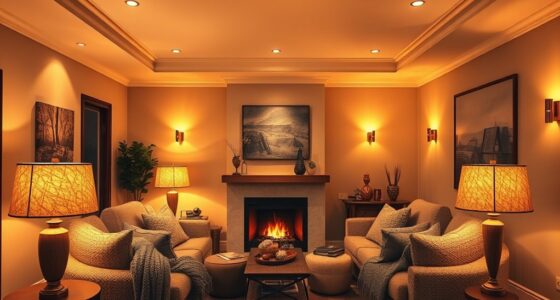If your home feels gloomy, you might be making common lighting mistakes. Relying only on overhead lights creates flat spaces, while ignoring layered lighting makes rooms dull. Using harsh, cool bulbs can also make areas feel cold and uninviting. Forgetting to maximize natural light and not placing fixtures properly can cast shadows and reduce brightness. Fixing these issues and exploring smarter lighting strategies will help transform your space into a warm, inviting home.
Key Takeaways
- Relying solely on overhead lighting creates flat, uninviting spaces without depth or warmth.
- Neglecting layered lighting results in dull, uneven illumination that diminishes room ambiance.
- Using harsh, cool-toned bulbs can make rooms feel cold and unwelcoming.
- Ignoring natural light sources and window treatments limits brightness and cozy atmosphere.
- Improper fixture placement and lack of task or diffuse lighting lead to shadows and gloomy areas.
Relying Solely on Overhead Lighting
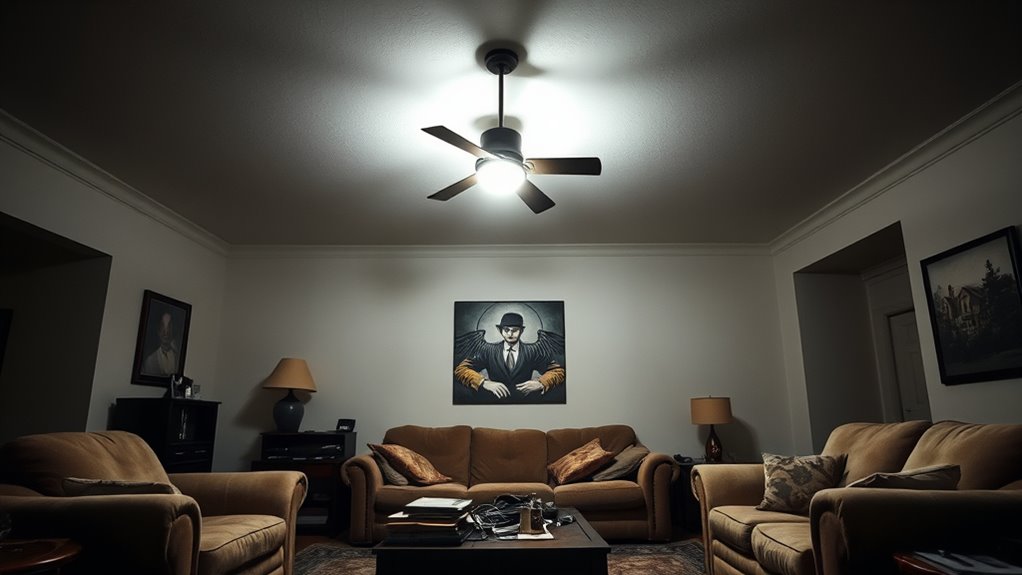
Relying solely on overhead lighting can make your home feel flat and uninviting. To create a warm, welcoming atmosphere, you need more than just ceiling fixtures. Incorporate ambient accents, like wall sconces or decorative lamps, to add depth and interest to your space. These softer lights help balance the brightness and prevent harsh shadows. Task lighting is equally important—use focused light sources for specific activities, such as reading or cooking. By layering different types of lighting, you avoid the flat, sterile feel overhead lighting alone can produce. This approach gives your rooms dimension, making them more functional and cozy. Additionally, color temperature adjustments can optimize the mood and visual comfort of your space. Remember, well-placed ambient accents and task lighting work together to transform your home into a more inviting environment.
Ignoring the Power of Layered Illumination
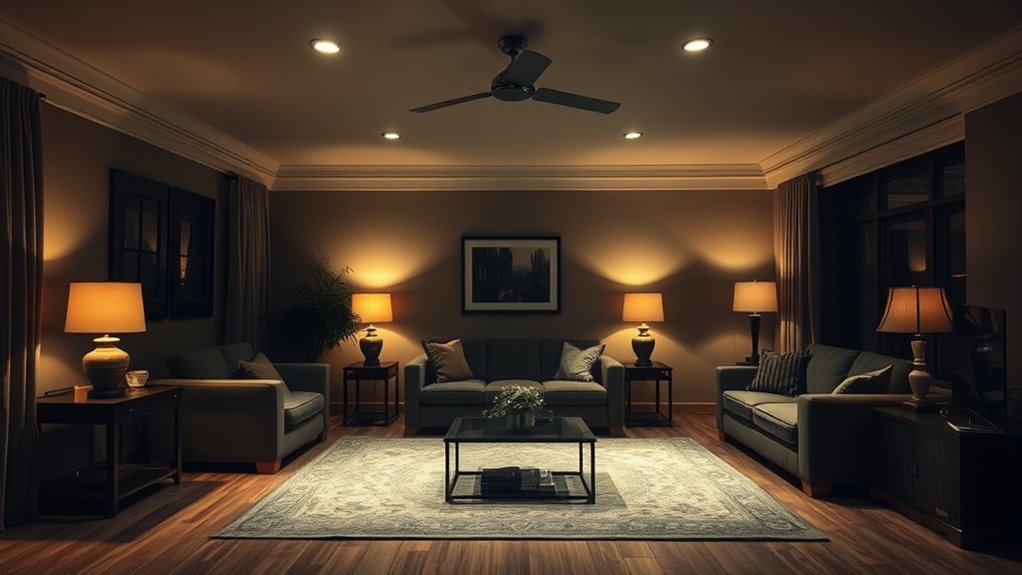
Focusing only on one type of lighting, like overhead fixtures, limits your home’s visual appeal and functionality. To brighten your space effectively, you need layered illumination. This involves combining ambient layering for overall brightness with task lighting for specific activities, creating a balanced environment. Without this, rooms can feel dull or unevenly lit. Proper layering ensures each area has the right light level, enhancing mood and usability. Incorporating lighting strategies can significantly improve your home’s atmosphere. Here’s a quick guide:
| Layer Type | Purpose |
|---|---|
| Ambient Layering | General, soft illumination |
| Task Lighting | Focused light for activities |
| Accent Lighting | Highlights decor or features |
| Decorative Lighting | Adds style and depth |
| Natural Light | Improves overall ambiance |
Using these layers together achieves a dynamic, inviting space.
Using Harsh, Cool-toned Bulbs
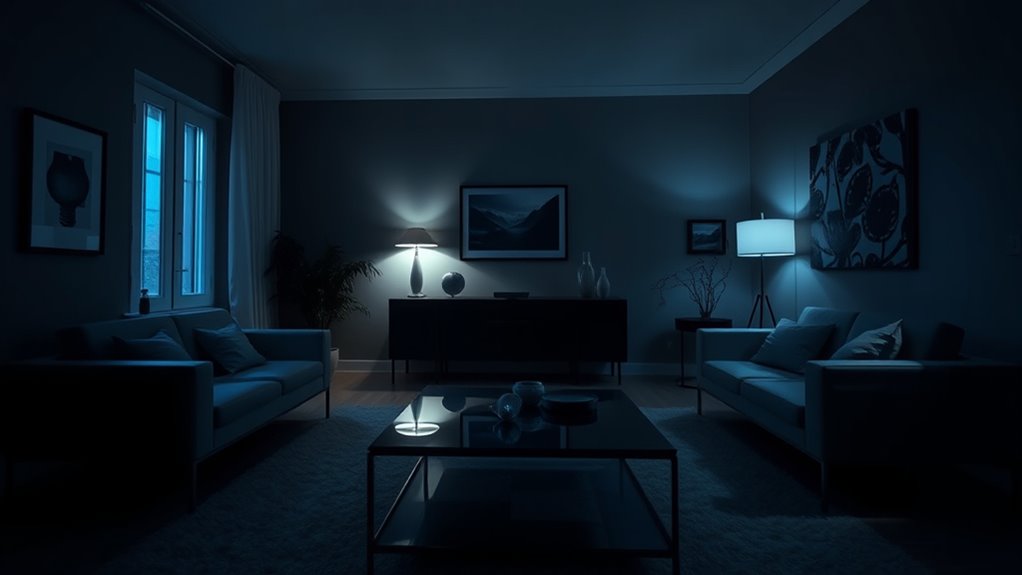
Harsh, cool-toned bulbs can make your home feel uninviting and sterile if you’re not careful. The key is understanding color temperature and choosing the right bulb choice. Cool bulbs typically have a higher color temperature, often above 5000K, which can create a clinical atmosphere rather than a cozy one. To avoid this mistake:
- Opt for bulbs with a warm color temperature (around 2700K to 3000K) for a softer, inviting glow.
- Avoid overly bright, white-toned bulbs in living areas; they tend to feel harsh.
- Mix different bulb choices to layer light without overwhelming your space.
- Use dimmable options to control intensity and set the mood more effectively.
Selecting the right bulb choice ensures your home feels warm, welcoming, and comfortable.
Forgetting to Maximize Natural Light
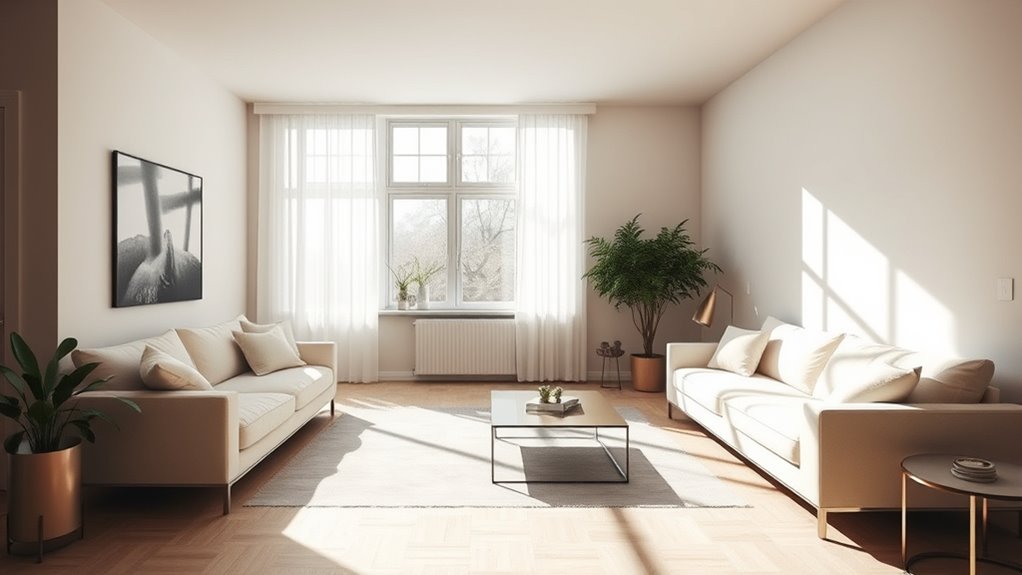
Maximizing natural light is essential for creating a bright, welcoming home, yet many overlook its full potential. Your choice of window treatments can make a big difference—opt for sheer curtains or blinds that can be easily adjusted to let in more sunlight. Keep windows clean to ensure maximum brightness and avoid heavy drapes that block light unnecessarily. Don’t forget outdoor lighting; well-placed exterior lights can extend natural brightness into your home during dusk and evening hours. Trim any outdoor foliage that might obstruct sunlight from entering. Additionally, lighting design plays a crucial role in how effectively natural light is utilized within your space. By optimizing how you use window treatments and outdoor lighting, you’ll flood your space with natural light, reducing the need for artificial lighting and instantly boosting your home’s ambiance and energy efficiency.
Neglecting Proper Light Placement and Fixtures

Have you considered how your light fixtures are positioned throughout your home? Proper fixture placement is key to avoiding a gloomy atmosphere. First, use diffuse lighting fixtures in larger rooms to evenly distribute light and reduce harsh shadows. Second, ensure task lighting is strategically placed near work areas like kitchens or desks for functionality. Third, avoid placing fixtures directly in line with your view, which can cause glare. Fourth, layer different fixture types—ambient, task, and accent—to create depth and warmth. Additionally, choosing the right lighting techniques can significantly enhance the overall brightness and mood of your space. By paying attention to fixture placement and choosing diffuse lighting where needed, you prevent dark corners and uneven lighting. This approach makes your home feel brighter, more welcoming, and balanced, transforming the overall ambiance effortlessly.
Frequently Asked Questions
How Can I Make Small Rooms Feel Brighter?
To make small rooms feel brighter, consider using lighter paint colors and avoiding dark color contrast. Place furniture thoughtfully to maximize space and allow light to flow freely. Mirrors can reflect light, making the room seem larger and more open. Keep window areas clear and add layered lighting, like table lamps or wall sconces, to enhance brightness. These simple changes will create a more inviting, luminous atmosphere in your small room.
What Are the Best Bulbs for a Cozy Atmosphere?
To create a cozy atmosphere, pick LED options with warm color temperatures around 2700K to 3000K. These bulbs emit soft, inviting light that makes your space feel welcoming. Avoid harsh, cool-toned LEDs that can make rooms seem sterile. Instead, opt for bulbs with adjustable brightness or dimmable features, so you can tailor the mood to your preferences and make your home feel more intimate and comfortable.
How Can I Improve Lighting Without Rewiring?
To improve your lighting without rewiring, start by upgrading your lighting fixtures with ones that suit your space and style. Add lamps or wall sconces to create layered lighting. Consider smart lighting options to easily control brightness and color temperature. These solutions let you customize ambiance effortlessly, making your home feel warmer and inviting without the hassle of rewiring, all while enhancing your overall lighting design.
What Are Cost-Effective Ways to Enhance Natural Light?
Did you know that opening your curtains can boost natural light by up to 179%? To enhance natural light cost-effectively, consider using light-colored paint for walls and simple window treatments like sheer curtains. Choosing bright, reflective color schemes helps bounce light around your space, making it feel more open and inviting. Keep windows unobstructed and clean to maximize sunlight, creating a brighter, more cheerful home without spending much.
How Do Different Light Colors Affect Mood and Space?
Different light colors, or color temperatures, markedly affect your mood and space. Warm light, with lower color temperatures, creates a cozy, inviting atmosphere, boosting emotional comfort. Cooler light, with higher color temperatures, feels more energizing and helps you stay alert. Choosing the right color temperature impacts emotional impact, making your environment more relaxing or stimulating based on your needs, and can transform how you experience each room.
Conclusion
By fixing these lighting mistakes, you might just find your home feels brighter and more inviting—almost like it was meant to be that way. Sometimes, the smallest change, like switching to warmer bulbs or adjusting fixtures, can unexpectedly transform your space. It’s funny how, in caring for our homes, we often stumble upon solutions when we least expect them. So, keep experimenting—you might be surprised how just a little light can make all the difference.


